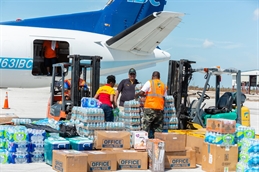
Logistics providers of all stripes joined a huge disaster relief effort to the stricken Bahamas after the islands were pounded for three days by the most powerful tropical cyclone on record to have hit the area, leaving a trail of destruction. The Category Five hurricane, which unleashed winds with speeds of up to 295 km/h, claimed at least 43 lives and wrecked tens of thousands of homes.
The first widebody charter reached the islands on September 5, flying in 34 tons of supplies organized by the Red Cross. The following day, two freighters brought in 76 tons of emergency supplies. On September 7, a charter organized by the UPS Foundation delivered nearly 20 tonnes of emergency supplies for shelters, hygiene and water purification procured by UNICEF, the Red Cross and other aid organizations.
Another 35 tons of aid materials collected by the UPS Foundation was flown to Nassau on a Boeing 767-300 freighter owned by LATAM Cargo, which provided the transportation.
“The Humanitarian Relief Plane is a true reflection of the LATAM Group’s desire to contribute to our community through concrete actions, acting when we’re needed the most. As we have done before in other countries in Latin America, we continue to be available for collaboration in mitigating the suffering of those most affected by natural disasters,” said LATAM Cargo CEO Andres Bianchi.
Ocean carriers also joined the effort. Container shipping and logistics conglomerate MSC Group mobilized a number of organizations in the maritime sector to fill two 40-foot containers with supplies going from Charleston to Freeport. The group of participants included various US port authorities, stevedores and labour unions. They dispatched over 200 gas generators, tarps, gas cans, canopy tents, power cords, water, toiletries and other items to the Bahamas.
With a deluge of relief supplies converging on the Bahamas, coordination is crucial. A broad number of relief organizations respond to disasters, all with the desire to get their goods as quickly as possible to the victims in the stricken area. To coordinate the various efforts and avoid bottlenecks, so aid can reach the affected areas as fast as possible, usually one relief organization takes a lead, working with the local authorities.
As a rule of thumb, medication and ready-to-eat meals are most urgently required, followed by materials that can provide shelters and blankets. Water purification systems and power generators are also in high demand. Items like clothing tend to be moved later.
Often the scope of relief work is massive. For the relief effort in Mozambique after Cyclone Idai hit Africa in March, Air Charter Service brought in 100 doctors and nearly 500 tons of aid materials, while Chapman Freeborn organized 15 freighter flights to the African country from Europe, the Middle East and North America.
Typically charters play a leading role in the relief effort, especially if the disaster occurs in a remote area not served with scheduled flights. This can pose a bit of a conundrum for relief organizations and charities that do not muster enough supplies to fill a freighter. In such cases charter brokers and forwarders can combine multiple shipments to maximize lift capacity.
The first freighter to arrive in the Bahamas after Hurricane Dorian was met by members of a DHL disaster response team (DRT), a group of DHL employees who work with airports, government agencies and relief organizations to coordinate the flow of relief goods. These groups are part of DHL’s ‘GoHelp’ disaster management programme that the logistics firm has run in partnership with the United Nations for more than 10 years.
“DHL’s DRT teams utilize their logistics expertise to provide practical, effective support at airports to ensure fast, well-organized handling of incoming aid supplies,” said Gilberto Castro, senior director operations Colombia and DRT director for the Americas.
DRTs carry out an assessment of the logistics infrastructure and help prevent bottlenecks at the airport that is closest to the affected area.
If the airport itself is damaged or otherwise unable to cope, alternative gateways have to be identified. When Idai struck Mozambique in March, the nearest airport was without power and it did not have a high loader to unload widebody freighters. A high loader had to be flown in from Europe. Before its arrival only freighters with proprietary handling gear could land there. Network Airline Management took an alternative route. The company flew 52 tons of relief equipment to Nairobi, where the load was shifted to 727 freighters which carried the cargo on three separate flights to Mozambique.
Charter brokers relish such challenges, but some do have some concern about freighter availability going forward. Dan Morgan-Evans, group director of cargo at Air Charter Service, wonders what will happen when Antonov-12 and Ilyushin-76 freighters will reach the end of their service life. This could usher in an era where planes that can fly to airports which lack suitable loading equipment will be in short supply, he warned.
By Ian Putzger
Correspondent | Toronto



